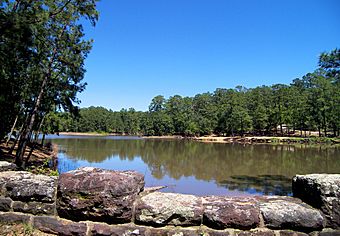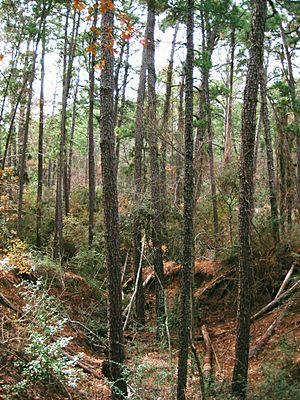Bastrop State Park facts for kids
|
Bastrop State Park
|
|

Bastrop State Park Lake is surrounded by the "Lost Pines of Texas" and is prime breeding ground for the Houston toad
|
|
| Nearest city | Bastrop, Texas |
|---|---|
| Area | 2,054 acres (831 ha) |
| Built | 1933 |
| Architect | Herbert Maier et al., A.R. Henry et al. |
| Architectural style | Bungalow/Craftsman, NPS Rustic |
| Visitation | 225,348 (2007) |
| NRHP reference No. | 97001242 |
Quick facts for kids Significant dates |
|
| Added to NRHP | September 25, 1997 |
| Designated NHLD | September 25, 1997 |
Bastrop State Park is a beautiful state park located in Bastrop County, in the middle of Central Texas. The park was created in 1938. It's famous for its special trees, like loblolly pines mixed with post oak and junipers.
Contents
Discovering Bastrop State Park's History
How the Park Began
More than 2,000 acres (810 ha) of land for the park were given to the state by the city of Bastrop in 1938. This was a big gift!
Building the Park: The CCC's Role
From 1933 to 1939, two groups of young men from the Civilian Conservation Corps (CCC) helped build many parts of the park. The CCC was a program during the Great Depression that put people to work. They used local stone to make the buildings blend in with nature. An architect named Arthur Fehr designed these buildings. They were so well-designed that they became examples for other parks built by the CCC. Because of this, Bastrop State Park was named a National Historic Landmark in 1997.
Growing the Park's Land
The State of Texas bought more land for the park over the years. In 1979, they added 1,450 acres (590 ha). Then in 2000, another 1,000 acres (400 ha) was added. This helped make the golf course bigger. More land was bought in 2001, bringing the park to its current size of 5,926 acres (2,398 ha).
Facing Challenges: Fire and Flood
In September 2011, a large wildfire, called the Bastrop County Complex fire, burned almost all of the park. About 96% of the park was affected. Only around 100 acres were saved. Most of the buildings built by the CCC were saved, but they were still in danger. The park had to close for a few months. After the fire, people started a big project to plant 4 million new trees. They hope to restore the forest within 30 years.
On May 25, 2015, the dam that held back Bastrop State Park Lake broke. This happened after many hours of heavy rain. The lake emptied out and flooded Texas State Highway 71. The water then flowed through a neighborhood and into the Colorado River.
Exploring Bastrop State Park's Features
What Can You Do at the Park?
The park has many trails for hiking. One popular trail is an 8.5-mile (13.7 km) loop that goes through the wilder parts of the park. There used to be an 18-hole golf course, but it closed in 2015. Now, you can walk or bike on the old golf cart paths. The park also has a large swimming pool that is open during the summer months.
Bastrop State Park is only 4 miles (6.4 km) west of Buescher State Park. The two parks are connected by a road called Park Road 1.
The Unique "Lost Pines" Forest
The most special part of the park is its stands of loblolly pines (Pinus taeda). These pine trees are unusual because they are about 100 miles (160 km) away from the main pine forests of East Texas. They are surrounded by post oak (Quercus stellata) woodlands. This is why they are called the "Lost Pines of Texas." You can also find different kinds of fungi here, like Pycnoporus cinnabarinus.
Animals of Bastrop State Park
Bastrop State Park is a very important home for the endangered Houston toad. It has the largest group of these toads that live on public land. To protect them, some areas of the park are closed during their mating season in February, March, and April.
Besides the Houston toad, you can also see other animals in the park. These include white-tailed deer, rabbits, squirrels, Virginia opossums, and nine-banded armadillos. Many birds also live here, like the bright red Northern cardinals.
Images for kids





